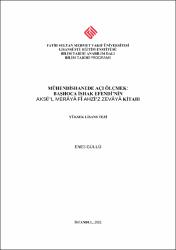| dc.contributor.advisor | Bilgin, Zehra | |
| dc.contributor.author | Güllü, Enes | |
| dc.date.accessioned | 2021-08-16T12:52:09Z | |
| dc.date.available | 2021-08-16T12:52:09Z | |
| dc.date.issued | 2021 | en_US |
| dc.identifier.citation | GÜLLÜ, Enes, Mühendishanede Açı Ölçmek:Başhoca İshak Efendi’nin Aksü’l Merâyâ Fî Ahzi’z Zevâyâ Kitabı, Fatih Sultan Mehmet Vakıf Üniversitesi Lisansüstü Eğitim Enstitüsü Bilim Tarihi Anabilim Dalı, Yayımlanmamış Yüksek Lisans Tezi, İstanbul 2021. | en_US |
| dc.identifier.uri | https://hdl.handle.net/11352/3808 | |
| dc.description.abstract | Günlük uğraşlar ve teknik işlemlerde ağırlık, uzunluk ve zaman gibi bazı büyüklüklerin miktarının belirlenmesine ihtiyaç hissedilir. Açı M.Ö 1500’lerden günümüze değin niceliği, farklı amaçlar için çeşitli yöntemler ile tespit edilmeye çalışılmış bir geometrik kavramdır. Bu tezde, bu kavrama bağlı gelişmelerin işlendiği Başhoca İshak Efendi’nin Aksü’l Merâyâ fî Ahzi’z Zevâyâ isimli eseri konu edinilmiştir. Dibacede gök küresinde açı ölçümüne yarayan sekstant ve oktant aletlerinin incelenmesi için yazıldığı söylenen bu eser, açı ölçümünde terk edilmiş yöntemleri işlemesi, bu yöntemlerin niçin terk edildiğini açıklaması, eskinin yerine kullanılan yeni yöntem ve aletlerin hangi açılardan daha iyi olduğunu belirtmesi sebebiyle bir açı ölçüm aletleri tarihi kitabı da kabul edilebilir. Eserde açının ne olduğunun, miktarını ifade eden birimlerin nasıl tanımlandığının, o güne kadar kullanılmış ve o gün hâlâ yaygın kullanılan yöntem ve aletlerin incelenmesinin yanında İslam ülkelerinde yaygınlaşmadığı vurgulanan daire-i in‘ıkâs isimli alete de yer verilmesi dikkat çekmektedir.Henüz yaygınlaşmamış bir ürünün yer alması bakımından eser, dönemin teknoloji transferinin mahiyetini anlamaya yönelik bazı ipuçları vermekte ve “İslam ülkelerinde henüz yaygınlaşmamış bir nev icad alet, yalnızca nihai ürün ve ürünün kullanım şekli ile mi yoksa arkasında yatan matematik ve mekanik özelliklerinin farkındalığıyla mı tanıtılmaktadır?” sorusunu araştırma imkanı sunmaktadır.
Araştırmada eser üzerinde teknik bir analiz yapılmıştır. Böylece bir aletin imalatından kullanımına ve sunduğu verilerin anlamlandırılmasına değin ihtiyaç hissedilen geometri, optik, astronomi ve mekanik bilginin yeterliliği değerlendirilmiştir.Açı ölçümü için insanlığı yeni aletler icat etmeye iten sebeplerin belirlenmesi ve Mühendishane Başhocası İshak Efendi’nin biyografisinde müphem kalmış kısımlara sunulan öneriler ve son matbu eseri olan mezkur kitabının transkripsiyonu da tezin bir kazancı olarak görülebilir. | en_US |
| dc.description.abstract | Measuring quantities such as weight, length and time is a necessity in daily activities and technical operations. Angle is a geometrical concept that has been researched since 1500 BC through different methods for different purposes. In this thesis, the book Aksü’l Merâyâ Fi Ahzi’z Zevâyâ by Başhoca Ishak Efendi, which deals with the developments related to this concept, is examined. The aim of the book is explained in the introduction as investigating the instruments octant and sextant which are used to measure angles on the celestial globe. However, the work can also be seen as a book on the history of angle astronomical instruments which are used in angle measuring; since it also deals with obsolote methods in angle measurement, explaining why these methods were abandoned, and stating in what respects newer methods and tools are better. Along with examination of the angle itself, how its units are defined, and the methods and tools that were used until the time of Başhoca as well as contemporary ones, the work is noteworthy as it reports and instrument called da’ire-i in‘ıkas -which is emphasized as not being used widespread in Islamic countries.Including a product that had not yet become widespread, the work gives some clues to understand the nature of technology transfer in the period and offers the opprtunity to research the question "Did a just invented tool that had not yet become widespread in Islamic countries is introduced only in terms of the end product and the way of use of the product, or it contain the awareness of the mathematical and mechanical properties behind it as well?"A technical analysis was done to evaluate whether geometrical, optical, astronomical and mechanical knowledge given in the work is sufficient manufacture the instrument, use it and the interpret the data obtained with it.
Among several outputs of the thesis are determining reasons that motivate mankind to invent new tools for angle measurement, conjectures that may shed light to unknown parts in the biography Başhoca İshak Efendi, and the transcription to Latin alphabet of his last printed work. | en_US |
| dc.language.iso | tur | en_US |
| dc.publisher | Fatih Sultan Mehmet Vakıf Üniversitesi, Lisansüstü Eğitim Enstitüsü | en_US |
| dc.rights | info:eu-repo/semantics/openAccess | en_US |
| dc.subject | Başhoca İshak Efendi | en_US |
| dc.subject | Mühendishane | en_US |
| dc.subject | Açı | en_US |
| dc.subject | Oktant | en_US |
| dc.subject | Sekstant | en_US |
| dc.subject | Teknoloji Transferi | en_US |
| dc.subject | Angle | en_US |
| dc.subject | Octant | en_US |
| dc.subject | Sextant | en_US |
| dc.subject | Technology Transfer | en_US |
| dc.title | Mühendishanede Açı Ölçmek:Başhoca İshak Efendi’nin Aksü’l Merâyâ Fî Ahzi’z Zevâyâ Kitabı | en_US |
| dc.title.alternative | Measuring Angles at Muhendishane: The Book Aksü’l Merâyâ Fî Ahzi’z Zevâyâ By Hoca Ishak Efendi | en_US |
| dc.type | masterThesis | en_US |
| dc.contributor.department | FSM Vakıf Üniversitesi, Lisansüstü Eğitim Enstitüsü, Bilim Tarihi Ana Bilim Dalı | en_US |
| dc.relation.publicationcategory | Tez | en_US |
| dc.contributor.institutionauthor | Güllü, Enes | |



















